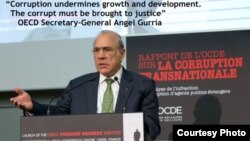The Organization for Economic Cooperation and Development has released a report showing the size and extent of bribery involving government officials and the companies that do business with states.
The report, released December 2, says the corruption is pervasive and rampant.
Procurement contracts are a massive area for corrupting public officials, the report says. In at least half of the cases studied, it says, CEOs and other senior corporate officials were involved in bribery and related activities.
The Paris-based Organization for Economic Cooperation and Development says bribes for public bids represented 57 percent of the 427 bribery cases examined. And three out of four cases involved the use of intermediaries such as agents or subsidiary companies to insulate top corporate officers from visible involvement.
But in 12 percent of the cases studied, corporate CEOs were directly identified.
Overall, bribes in these cases were the equivalent of 10.9 percent of the total value of the transactions involved. That, the report says, represents $13.8 million for each.
Four sectors represented nearly two-thirds of the bribery cases.
The largest number involved extractive industries such as oil, gas, and mining, which represented 19 percent of the total. That was followed by construction at 15 percent with transportation and storage also at the same level. Another 10 percent of the cases involved information and communications deals.
The OECD report covers bribery cases since February 1999 when the organization’s “Anti-Bribery Convention” was enacted. Currently, 41 nations are signatories.
OECD Secretary-General Angel Gurria prefaced the report by saying that “Corruption, and the perception of corruption, erodes trust in governments, businesses, and markets.”
”On the one hand, businesses forego innovation and competiveness for bribery,” he said. “On the other hand, individuals within governments divert funds for their own personal use that should be used to promote the well-being of people.”
But justice appears to be slowing down, according to the OECD.
From 2006 to 2011, there was a steady increase in the number of bribery prosecutions concluded. But that number fell by nearly half the following year, followed by a further slight decline in 2013.
Resolution
In explaining that trend, the report says the time needed to resolve bribery cases has markedly increased since 1999, when resolution averaged two years, to more than seven years today.
“This may reflect the increasing sophistication of bribers, the complexity for law enforcement agencies to investigate cases in several countries, or that companies and individuals are less willing to settle than in the past,” the report said.
Jose Ungaz, chairman of the corruption watchdog Transparency International, said the OECD report can help shape the international battle against corruption.
“The information provided as a consequence of research on the 427 cases is very valuable information that we can use as a tool to combat corruption,” he said. We still see high level officials, even heads of state, receive bribes through political financing and other means,” he said in a statement. “We also see many times that nothing happens, [and] the corrupt are getting away with it.”
The OECD reports that heads of state were involved in 5 percent of the bribery cases. Government officials and state-owned enterprises were involved in 27 percent of the bribes while 11 percent cited customs officials.
Twelve percent of the bribes paid out involved customs “clearance.” That was followed by health officials in 7 percent of the cases. Another 6 percent involved defense ministry executives. The study noted instances where public officials established identity-cloaked corporations through which bribes were paid.
As for how this this bribery was brought to light, the OECD says one in three cases were reported by the companies or by individuals. This came about through internal audits 31 percent of the time, according to the report. In another 28 percent of the cases, it was discovered through the due diligence process during mergers and acquisitions.
Another group of cases – 13 percent of the total – were the result of either formal or informal multinational cooperation. Another 13 percent were the direct result of investigations initiated by law enforcement entities.
But the report says only 2 to 5 percent were uncovered by “whistleblowers” – people within governments or corporations who went to authorities with bribery information or through investigative journalism by the media.
The OECD says fines were imposed on companies and individuals in 261 of the 427 cases bribery examined. The largest fine assessed against a single company was nearly $2.223 billion while the largest penalty imposed on an individual was the forfeiture of 149 million.
Punishment
In all, 80 persons were handed prison sentences for corruption in the OECD cases with 38 others being given suspended sentences.
In foreign bribery cases, the most common penalty was the imposition of sanctions – blocking offending corporations from bidding on future projects and other activities. This took place in 69 percent of the cases.
Since the 1999 onset of the organization’s Anti-Corruption Convention, the United States has imposed sanctions in 128 bribery cases. Germany “debarred” [sanctioned] in 26 instances while South Korea took such action in 11 instances. Britain, Switzerland, and Italy each imposed sanctions in six cases.
“Bribery schemes often span the globe without regard to country borders,” said Assistant U.S. Attorney General Leslie Caldwell , who took part in unveiling the OECD report. “A coordinated response by international law enforcement is necessary to ensure that all of the culpable individuals are held to account, and to deter future would-be wrongdoers.”








